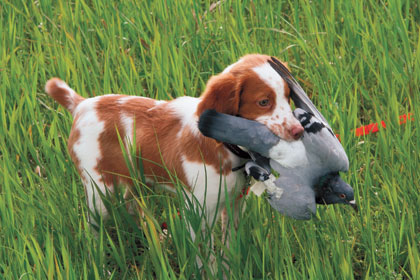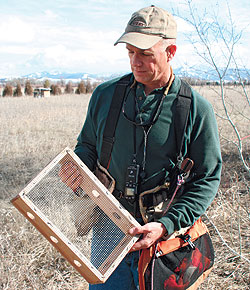Introducing your pup to birds before you begin obedience training can prevent future problems.
By Dave Carty
My favorite bumper sticker, which I keep threatening to post above the door to my office, reads: Earth First! We'll Log The Rest Of The Planets Later. I love the humor, even if I don't necessarily share the sentiment.
 Don't get upset if your young pup traps or grabs a bird. It's bound to happen sooner or later, and it doesn't mean he won't develop his pointing instinct. |
Likewise, Birds First! should be the modus operandi of every pointing dog owner.
There are, of course, those who would disagree. They want their dog to sit, come to the whistle, whoa, and dance the hootchi kootchie before it ever sets eyes on a real live bird.
Most of these folks are in the retriever camp, and if there's one thing I've learned in my admittedly limited experience with retrievers, it's that I don't want to argue with the people who own them.
You own a pointing dog, though, which is presumably why you're reading this. So why introduce your pup to birds before obedience and yard work? There are two reasons.
The first is that, done properly, it almost always increases prey drive. Second, it will provide you with a training "cushion," a safe place for your pup to go when he's tired, frustrated or bored. Birds will put a smile on his little mug and give him something to look forward to after training sessions.
If, like me, you are genetically predisposed to making stupid decisions from time to time, a planted bird or two will ease your dog over hurdles you may have all-too-clumsily put before him. Said another way, exposure to birds early and often will cover your butt. It has covered mine more times than I can count.
There are several ways to do this, and the easiest by far is to plant birds — pigeons, quail, chukars, whatever you've got — for him. Of course, the drawback to this method is that few folks have the time, temperament or space to set up a pigeon coop or callback pen. There are, however, a few creative ways around that.
It's entirely possible to buy or build a small cage, say three by three feet, set it up under your porch eave or someplace else protected from the weather, and stock it with two or three pigeons, all you'll need for the first few weeks of your pup's exposure to live birds.
Since, initially at least, you'll want to tether or cage your planted birds so they can't fly away, losing them won't be a problem. Another way, and a good one, is to join the nearest sporting dog club and attend their weekly or monthly training sessions. They'll have birds you can buy or rent.
But if neither avenue is open to you, a workable option is happy timing. Happy timing is a term a mentor of mine explained to me long ago, which simply involves taking your pup out for runs in the country.
 Using a small box or cage to confine your training birds ensures they won't flap around and startle a young pup. |
He'll learn to point or flush whatever birds he finds, as well as grasshoppers, horses, and anything else that catches his fancy, and he'll learn to hunt too, as the world comes alive through the wonderful nose he's beginning to discover.
In fact, this is something I recommend to anyone with a puppy, whether or not they have penned birds at their disposal. How often should you do this? You can't do it too much.
Several times a week, minimum, and once a day isn't pushing it.
The two dogs I have in my kennel this summer are a case in point. Both had some exposure to planted birds when they were little. Annie, a pint-size Brittany, took to pointing pigeons right from the start, at the tender age of 10 or 12 weeks. June, a setter, wasn't nearly so precocious. Pigeons weren't something she was particularly interested in, and after briefly nosing the birds I'd planted for her, she'd dash off, ready for some other adventure.
I suggested both owners take their dogs for happy-time runs, letting them find and chase all the trash birds they wanted. Surprisingly — I'm always surprised when people act on my advice — they did.
This spring, a year later, both dogs were back. Both, at around a year of age, had had months of happy-time runs (as well as an occasional planted quail). Annie's drive to find birds and point them was stronger than ever. And June had made a complete turnaround.
Birds were now the center of her existence. Her drive to hunt, in fact, was strong enough that I've been able to jump ahead with the next phase of her schooling.
Like everything else in the dog-training world, there's a right and a wrong way to expose a puppy to his first birds. My youngest setter, Hanna, got her first planted pigeon at exactly 49 days of age. Since the last thing you want is a flapping bird scaring an impressionable puppy, make sure the bird is secured in a bird sock, or, easier still, take a couple turns of masking tape around its middle to lock its wings and legs in place. Then put the pup on a leash and lead it a few feet downwind of the bird, letting the pup use its nose to discover the bird on its own.
At that point, anything can happen. I've seen puppies pounce on the bird, grab a wingtip, and race around the yard, towing the bird with it. I've also seen them sniff it for a moment or two, then ignore it. And I've seen them take a step or two back, startled, and avoid any further contact. The thing to remember is that while scenario one is ideal, scenarios two and three are common and in no way indicative that your pup isn't "birdy."
However your pup reacts, proceed with caution. New research (I've been told) indicates that puppies are highly impressionable from eight weeks to 10 weeks of age, and at least one reputable trainer I know no longer introduces his pups to birds during those weeks. I haven't had a problem so far, but waiting until the dog is 11 or 12 weeks old, or even older if you want to be absolutely safe, is fine.
 Some pups, like this Brittany, start pointing at a very young age, while others may take several months to develop. Don't be concerned if your pup is one of the late bloomers; they all start pointing eventually. |
In any event, once your pup is comfortable with a trussed pigeon, introduce him to a bird that has one wing free, then both, and so on. More often than not, that flapping wing will make a birdy puppy even birdier, and ignite the sleeping passion in a slow developer. But if not, if that slow developer shows signs of intimidation, back off and revert to a completely trussed bird. Never rush things.
What you eventually want, and what you should look for, is a puppy that is actually hunting — scouring the grass for scent, using his nose and his eyes to find the bird he knows is there. When he does that, if only for a few seconds at a stretch, he's arrived.
You could, if you wanted to, take him off birds at this stage, but I never do. It's just too much fun watching them develop.
Like any other training technique, expect screw-ups. If your pup is intimidated by the bird, back off, give him a day or two to rest, and try again. If he's still scared, give him a few weeks to mature, but keep up the happy-time runs. And if your puppy grabs the bird and tries to chew it? Won't that create hardmouth or turn him into a flusher? Nope. I've yet to train a young dog that didn't trap or grab a planted bird sooner or later, and not a single one has ever failed to develop its pointing abilities.
If your pup grabs a pigeon, take the bird away forcibly but gently, and don't reprimand him! Then, plant future birds in a bird box. You can easily make one yourself, or buy one of the heavy wire trap baskets that serve the same purpose. Much later you can plant birds in actual traps, the type that spring a planted pigeon or quail into the air. But don't use these on a very young dog — the noise may scare them.
Finally, the big question: what if your puppy won't point? Chill, dude. It's been my experience that most puppies won't point on initial bird contact. As long as your pup is showing interest in the bird you're ahead of the game. Pointing will come later, and almost always does.
How late? Beats me. Some puppies, like Annie, point birds at seven weeks; other dogs, like my point-crazed setter Scarlet, don't start pointing until seven months. As long as the interest is there, the pointing will follow.
Getting your puppy into birds on a regular basis takes effort, but of all the stages of dog training, this is the one I enjoy most. Missing a puppy's first point is like missing your kid's first football game. True, you'll both get along without having had the experience.
But do you really want to?






